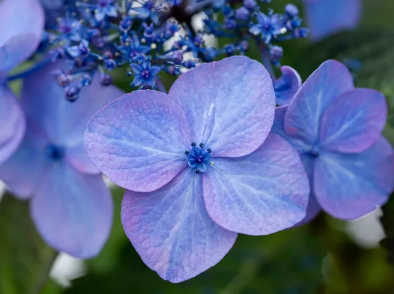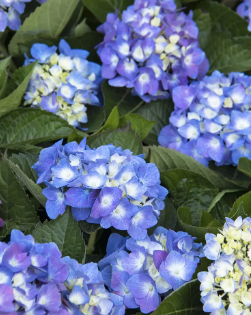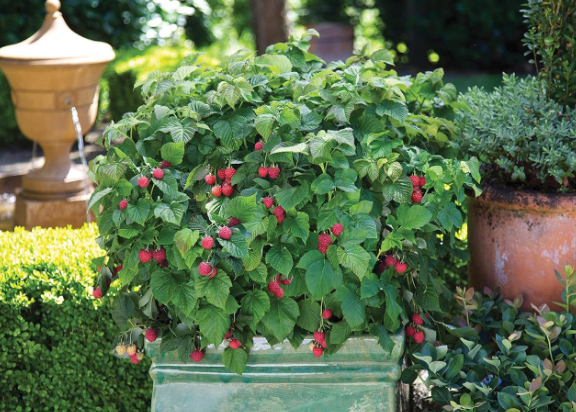
Experience the Professional Quality of Felco F-12 Classic Pruner – A Must-Have Tool for Every Gardener
September 5, 2024
The AUTOMAN Garden Hose Nozzle: The Ultimate Watering Companion for All Your Gardening Needs!
September 9, 2024Of all the hydrangeas currently on the market, there is only one that produces beautiful blue flowers, and these plants are famous for this flower. Often referred to as large-leaved hydrangea (Hydrangea grandiflora), this type is unique because the flowers (technically sepals) can be bright pink, purple to bright blue, depending on soil acidity. You can admire these stunning blue flowers on dozens of varieties in the style of mop heads or lace hats. The best blue hydrangeas on this list also have improved characteristics such as reflowering, compact size, and stronger hardiness.
Big-Leaf Hydrangea Planting Tips
Large-leaved hydrangeas are native to East Asia and are hardy in zones 5-9 (some varieties are even more coldy). They prefer moist soils rich in organic matter, well-drained, and partially sunny, although they can withstand plenty of sunlight in cooler summer areas as long as they are given plenty of moisture. In colder regions, you may want to provide some winter protection to ensure that hydrangeas bloom the following year.
Nikko Blue

If you’ve seen giant blue hydrangeas before, chances are you’ve seen this variety. “Nikko Blue” from Japan reliably turns blue in home gardens and, like the large-leaved variety, grows to about 6 feet tall and wide. Plant your “Nikko Blue” in moist, well-covered soil and in partial shade so that they look their best throughout the growing season.
Endless Summer

Endless summer is often considered a game-changer for hydrangeas because of their ability to produce flower buds in both new and new growth processes, unlike species that only produce flower buds during the previous year’s growth process. This ability and cold hardiness reaches zone 4, allowing northern gardeners to enjoy the “dragging” flowers of the large-leaved hydrangea without fear of losing their buds in winter. Endless Summer is slightly shorter in length than this species.
Pop Star

The Pop Star is the latest addition to the Endless Summer range, with electric blue lace capitate inflorescences all summer long on very sturdy stems. These plants are quite compact, reaching only 3 feet tall and wide when mature. Pop Star is also very tenacious and reliably returns to District 4 every spring.
Blue Enchantress

Another re-blooming blue hydrangea is hardy, and the “blue enchantress” has a maximum height and width of about 5 feet, making it more compact than this species. The flowers start out light sky blue and eventually turn creamy green.
Blue Jangles

“Blue Jangles” from the Let’s Dance series is an improvement on the colors of the Heavy and Dwarf Flower categories. This small hydrangea can only grow up to 3 feet tall and is very compact, making it perfect for tight spaces and containers.
Starlight

Another product in the Let’s Dance collection, “Starlight”, produces gorgeous lace flowers. Unlike the traditional mop head look, the lace cap produces a flattened head inflorescence that blooms more sporadically, resulting in a starry appearance. It can reach a height of up to 4 feet and is best suited for planting in zones 5-9.
Big Daddy

“Big Daddy” goes in a completely different direction in terms of size and flower shape, it is a large hydrangea that grows up to 6 feet tall and produces huge mop-headed flowers. This gentle giant is a little more sensitive than most on the list, prefers partial shade and constant moisture to maintain its huge flower heads, and is only resistant to zone 6 and higher.
Cape Cod

Coming back to the smaller end, “Cape Cod” is part of the Seaside Serenade series, which combines small size (about 4 feet tall and wide) with cold hardiness down to Zone 4. This blue hydrangea is ideal for underground planting, growing in the north, and growing year-round in potted plants further south. “Cape Cod” is a repetitively flowering flower with a single flower in two shades, blue and white, giving it a unique appearance.
Twist-N-Shout

“Twist-N-Shout” combines hardiness with a maximum size of 4 feet tall and wide, lace style, and repeating flowers. The light blue of the flower heads stands out against the dark, unopened buds, creating a beautiful and striking effect.
Keep the Blue Color of the Blue Hydrangea
In alkaline to neutral soils, large-leaved hydrangeas produce pink flowers, while in acidic soils, they produce blue flowers. Therefore, if your soil pH is neutral or high, you will need to treat the soil around the blue hydrangea with aluminum sulfate to keep it blue.
While there are many home remedies for acidifying soil, such as mulching with pine needles and coffee grounds or citrus peels, the best and most effective way is to purchase ready-made soil acidifier products at your local garden center. These products not only work, but also have longer-lasting results. They contain acidifiers and aluminum, which are also necessary for the production of blue hydrangea. In addition, some of these acidifiers contain additional phytonutrients to support the overall health of the plant. It is planned to add acidifiers in the spring before the buds begin to bloom and again in late fall.



